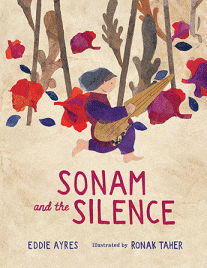
Sonam and the Silence
Sonam and the Silence
Eddie Ayres
Ronak Taher
Allen & Unwin, 2018
32pp., hbk./, RRP $A24.99
9781760293666
When Sonam turns seven, she is deemed no longer a child and her big brother orders her to cover her hair and begin to work. But the streets of Kabul and its market are too loud and scary for Sonam, the cacophony making a storm in her head and so she runs. As she runs, she hears a strange sound and follows it, finding an old man with milky eyes and a curved spine in a garden of mulberry and pomegranate trees. In his arms he is cradling a rubat, making music that Sonam has never heard before because in Taliban Afghanistan music has been banned.
The music captures Sonam’s heart and each day she visits the old man, learning to play the rubat that he has given her – the one he played as a child. But when her brother hears her humming and investigates further, he takes Sonam’s rubat forbidding her to sing or play again. And as the noise builds in her head again, and the roar of gunfire and rockets is so close, she becomes withdrawn and her heart shrinks. Until one day, she knows she just has to go back to the pomegranate garden…
This is “a lyrical fable-like story by the well-known musician, author and broadcaster Eddie Ayres, about the irrepressible power of music.” Based on his own experiences in Afghanistan and a young girl he knew there, he challenges the reader to think what a world without music would be like, particularly as it is often the key connection between peoples with no other common language. But as Sonam discovers, even if there is no audible external sound, there is still music.
Illustrated by Iranian-Australian visual artist Ronak Taher using sombre colours and many layers and textures, which offer uplifting features like Sonam floating above the noise and chaos of the city, this is a thought-provoking story about how other children live in other parts of the world, and, indeed, how some of those in our classes have lived. While music has now been allowed in Afghanistan, the six years that the silence reigned must have been devastating for those for whom music is as essential as food. Readers are challenged to consider what their life would be like if something they held dear was banned, and if others prevented them from indulging in it because of the dangers such behaviour could invite. Ayres suggest an Australia without sport, but what about a country without books? As with no music, how would the stories be told and continued?
As Christmas draws closer and the hype escalates, this is a book to share and consider those whose lives are very different and for whom joy comes from something other than a brightly wrapped present.